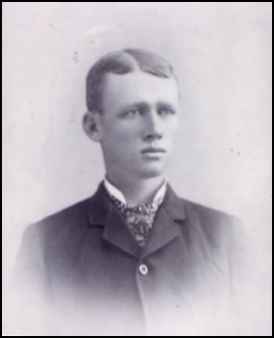
 |
|
21 Years of Age Collection of Cebe Hanson, 3-15-04 |
|
by his daughter, Dorothy Benbow Ragsdale Collection of Cebe Hanson, 3-15-04 In the year 1862, the family migrated from North Carolina to New Providence, Hardin County, Iowa. While living here, his father practiced medicine. In 1874, when Thomas was ten years old, the family moved to Colorado Springs, Colorado. He lived here as a youth and attended school until the eighth grade. His family was of the Quaker faith, and his father was a very strict disciplinarian. Probably due to this condition, Thomas rebelled at the age of sixteen or seventeen years and ran away from home, finally arriving in North Park, Colorado. An incident that happened when a young man might be added here. While hunting, as he was crawling through a fence, his gun dischjarged and a bullet entered his right leg. Due to this accident, he carried this bullet in his leg the rest of his life. During the first years of his residence in Colorado, he followed the occupation of a cowboy and horse breaker and was a range pal of Montie Blevins Sr. who became his brother-in-law. In 1892, after living six years in North Park, Colorado, the family journeyed to Absarokee, Montana by covered wagon. There were three families from Colorado travelling with them. The trip was of six weeks duration, for they were bringing livestock as well as taking care of the family, washing, cooking and baking bread enroute. Since there were no bridges over rivers of streams, it was necessary to ford or make rafts for the crossings. The family settled on a homestead south of Absarokee, joining Con and Jim Mendenhall, Ida's brothers, who had settled here a year earlier when this Indian reservation was opened for homesteads. While living here and farming the ranch in the Stillwater Valley, four children were born to the family. Cebron Alfred, October 6, 1894, died July 23, 1972, Marguerite Louise, December 28, 1896, Dorothy Agnes, May 23, 1899, and Chalkley Mendenhall, August 22, 1902. To describe this man is rather had for he was a lover of nature, interested in geology, and he possessed an inventive and scientific mind. He devoted much time prospecting in the mountains nearby. Around the year 1900, he invented the well-known Car Coupling Pin, and applied for a patent, but his application was two weeks late. Today this same pin is used on all railroad cars. His objective was to enter the Aerial Races at the Exposition Fair at St. Louis, Missouri, October 27, 1904, and win the $100,000 prize. The trial runs were successful, but on the day the final races were held, a wind arose during the flight and the "Meteor" was caught in a number of lines. He was disqualified from the race. This mishap was a terrible disappointemnt ot him. His father, Dr. Thomas A. Benbow, had traveled from Colorado Springs, Colorado to St. Louis to witness his son's great dream. A Montana friend, Harry Wells, and a believer in this project accompanied Thomas in the cage and helped him manage the steering apparatus. and Montana newspapers provide detailed information about the trials and the race.) Meanwhile, in the summer of 1904, Ida and the children moved to Columbus from the ranch in the Stillwater Valley. She was anxious for Emma and Mary to enter high school for further education. In 1907 the family moved to a ranch on Keyser Creek four miles north of Columbus where they resided for two years before moving back to Columbus. During this time Thomas was building a cabin on Rock Creek near the chrome claims which he was busy mining. One summer he managed a butcher shop at Cooke City, Montana. This location was convenient to surrounding mountains where he was still prospecting. A few years later, either in 1917 or 1918, Thomas owned a bar at Absarokee. This business greatly disturbed the family. In 1918 during the First World War, chrome was used to harden steel, and today chrome has many uses. Several men and promoters came from New York in 1918 and suggested a price of $900,000 to take over the mines, but Mr. Berg opposed their offer thinking if the mines were worth that much, why not retain them and do their own development in time. In the years of 1921 or 1922, another company arrived from New York and leased the mines for development, seeking ways and means to get ore to the railroads. They paid approximately $35,000 for this project which was of a year's duration. Thomas gave shares in the corporation to many people who grubstaked him in the chrome mines. Many people called him a dreamer for he worked year after year developing the chrome mine and hoped that he and his family would prosper. His dream of productive mine came true, but not before his death from cancer on December 17, 1932. During World War II for a contract of $50,000,000 The Anaconda Company managed the Benbow Mine to produce chrome for the government. |


|